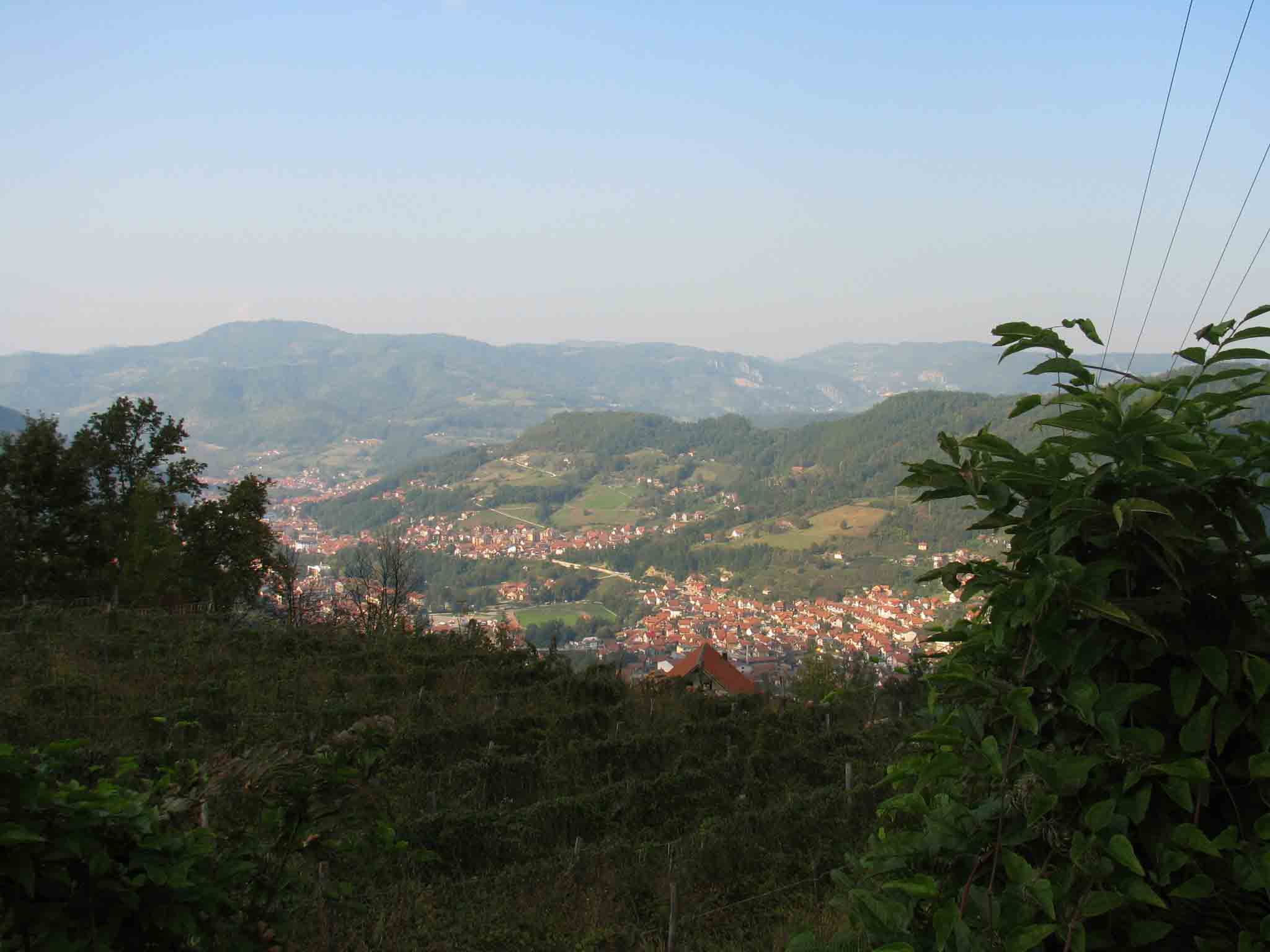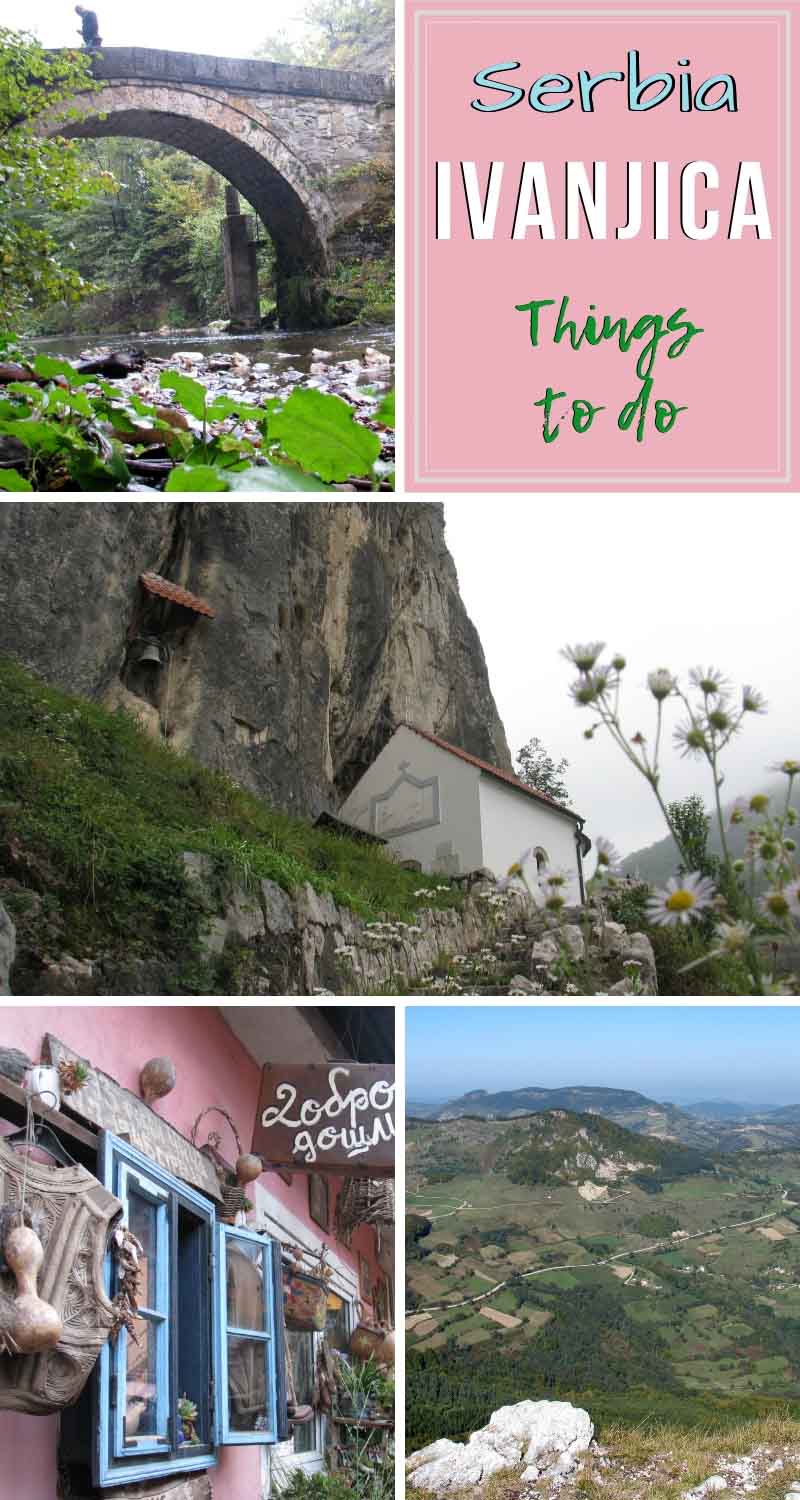
If you need a freelance travel writer or you would like to see your country, city, flight, etc., presented on the blog, drop me an email.
Find our more on Freelance Travel Writer page.
Next time you travel to Western Serbia, venture a bit further south from Čačak and stop by Ivanjica. Once you arrive, you’ll find countless things to do in Ivanjica Serbia—whether exploring historical monuments, hiking on Golija Mountain, visiting 13th-century monasteries, or discovering caves and lakes. It’s all conveniently located within a few dozen kilometers!
FROM BELGRADE: About 190 km
FROM NIŠ: About 215 km
Picture a town embraced by towering mountains, nestled in a valley with breathtaking views of rocky peaks. From above, a cluster of red rooftops emerges—a charming sight. Yes, that’s Ivanjica! Known for its pristine air and crisp winters (as this one is), it often feels like a secluded world. But don’t be fooled; the locals’ witty humor and warm character make it the perfect home for the Nušićijada Festival.
(Interestingly, the festival is dedicated to the famous Serbian 19th-century playwright and satirist Branislav Nušić, who never actually visited Ivanjica. The town was historically considered “the end of the world.” In The Cabinet Minister’s Wife, Nušić’s character famously threatens to send someone to Ivanjica, inspiring locals to “bring Nušić to the end of the world” with this event.)
My journey to Ivanjica Serbia was even more adventurous since I wasn’t coming from Belgrade but from Kokin Brod to the west. I drove across the dam on Zlatar Lake (see the post about the stunning Uvac Canyon), through picturesque settlements like Jasenovo and Močioci, and past Mučanj Mountain. The winding mountain road led me to Katići village after about 40 kilometers, then another 15 to Prilike village, and finally to Ivanjica.

Ivanjica Serbia
Situated in southwestern Serbia, Ivanjica was officially established in 1833. It is one of the largest municipalities in the country by area, with a population of 32,000, of which 12,000 live in the town itself. Ivanjica rests on the banks of the Moravica River, which springs from Golija Mountain at an altitude of 468 meters. Declared an air spa in 2000, this region boasts forests covering half of its territory.

Your first impression of this small town will likely be its charming character and the handful of landmarks in the town center. Grab your camera and explore on foot—it’s always the best way!
In the center, a wide pedestrian zone awaits, where you must try the local krempita cake. Nearby, you’ll find the Stone Bridge over the Moravica River. Built in 1906 entirely from stone blocks, it is said to be the largest one-arched bridge in the Balkans. Still in use today, it’s a place where locals often stop to chat.

Further down the river, the old power plant, built in 1911, is worth a visit. It was the seventh power plant constructed in Serbia and still functions, illuminating the park’s lanterns. Transformed into a museum, it sits near a concrete dam with a 9-meter-high artificial waterfall. Stroll along the riverbank and stop by the Park Hotel, often regarded as the best accommodation in Ivanjica Serbia. (A few years later, I had the chance to stay there overnight. Highly recommended—everything is close by, you have parking, a cozy room, great food, and even a pool.)
A visit to the power plant wouldn’t be complete without hearing some local anecdotes. One story recounts how villagers from the entire region contributed to its construction, hoping to bring electricity to even the most remote areas. However, when the power plant was completed, those villages remained in darkness. Officials explained: “We did everything we could, but the electricity simply refuses to flow—uphill!”

Another tale tells of how Ivanjica residents once built a railway station, even though the railway tracks never reached the town. The station building still stands, a quirky nod to the town’s spirit and a fitting backdrop for the annual Nušićijada Festival every August.

Don’t miss the 1836 church dedicated to Emperor Constantine and his mother, Helen. It is the only surviving building from that period and withstood two devastating fires that destroyed the rest of the settlement.

Across the street stands a monument to Draža Mihailović, the renowned King’s Army General during World War II.
While strolling Ivanjica’s streets, I stumbled upon a souvenir shop located in what the owner claimed to be Mihailović’s childhood home. It’s a lovely spot to pick up a keepsake.
After some exploring, it was time for a coffee break. Pair it with krempita or princes krofne dessert before setting off for a short ride.

Hadži-Prodan Cave
Just 7 kilometers from Ivanjica, toward Guča village, lies Hadži-Prodan Cave. Named after a famous 19th-century Serbian Uprising leader who used it as a hideout, the cave also holds evidence of Neanderthal habitation. Excavations have uncovered tools dating back 40,000 years and rare quartz artifacts. Adjacent to the cave is a small church, built on the site of the original 1809 structure.
The cave extends 400 meters across two floors. Its 3-meter-wide entrance leads to a narrow corridor, which opens into a magnificent hall.

Though not yet open for tourism at that time (and is fully operational now), the Tourism Organization of Ivanjica graciously gave me a tour.
Our visit took an exciting turn when the flashlights and noise startled a colony of bats from the darkness. Even Radomir, the former Tourism Office Head leading the tour, admitted it was a first! After calming down and redirecting our lights to the floor, we pressed on cautiously. The reward? Stunning cave formations reaching toward a ceiling dozens of meters high.

For adrenaline enthusiasts, a zip line near Hadži-Prodan Cave was opened in 2019. It is the longest in Serbia at 530 meters, and its unique feature allows rides in both directions.

Golija Mountain
Golija is the highest mountain in southwest Serbia, with Janko’s Stone as its tallest peak, reaching an impressive 1,833 meters. Declared an air spa and a first-category Nature Park in 2000, Golija was also recognized as a UNESCO Biosphere Reserve in 2001. The mountain is abundant in lush forests, pristine mountain springs, a variety of herbs, and rich wildlife.

Not only does Ivanjica trace its roots back to 1833, when the town was founded, but its connection to Golija reaches sky-high—1,833 meters, to be precise! This is the height of Golija’s highest peak and undoubtedly one of the top things to experience in Ivanjica Serbia. No wonder I couldn’t wait to climb up there, even though I had heard how vast and untamed this mountain is. When the day for exploring Golija finally arrived, the morning greeted us with thick clouds and fog. Despite the stretch of sunny October days, Golija showed off its unpredictability. Still, seeing the mountain cloaked in dense mist was a once-in-a-lifetime experience.
Clouds and mist accompanied us all the way up. Keep in mind that most of Golija’s roads are unpaved macadam tracks, so driving is slow, and distances feel longer than they appear on a map. Be prepared for dozens of kilometers of winding roads, climbing through dense forests. A must-see is Tičar Lake (also known as Daićko Lake), located on Daićko Hill at an altitude of 1,500 meters. Shrouded in mist and surrounded by towering pine trees, the lake seemed almost otherworldly. Golija is also home to the Sky Tear Lake (Nebeska Suza) in Okruglica and the Košanin Lakes—rare natural wonders that add to the mountain’s charm.
As we approached Janko’s Stone, we rose above the clouds. The sky at the summit was gloriously clear, while the clouds below cascaded over the hills like waves. This is where I heard the tale of how the peak got its name.
“Once upon a time, brothers Janko and Ranko fell in love with the same girl. To decide who would win her hand, they agreed on a contest—the first to carry a massive rock to the top would be the victor.”
Janko reached the summit first.
“So, did he win the girl?” I asked eagerly.
“No,” came the reply. “He got there first… and then he died!”
(It’s hard to decide whether to laugh or cry!)

Just 16 kilometers from Ivanjica lies the village of Kumanica, home to the so-called Roman Bridge—a fascinating addition to any Ivanjica Serbia itinerary. Here, the West Morava River is called Moravica, and the bridge, believed to have been built and rebuilt multiple times, spans 14 meters in length and 4 meters in height. Locals associate it with the Roman era, though its current form showcases Turkish architectural elements and is thought to date back to the 15th century. The bridge was once part of an old trade route used by merchant caravans. (I visited again a few years later, see the post West Serbia Places to visit.)

Returning to Ivanjica, we visited the Kovilje Monastery in the village of Smiljevac. Kind-hearted nuns offered us tea, which was much appreciated after hours of foggy driving. They showed us the feather grass, or kovilje, that has carpeted the surrounding hills for centuries. With its unusual leaves, this “fairy grass” is steeped in local lore. It is believed that an ancient pagan sanctuary once stood here, and its mystical aura has lingered through time.

The monastery itself, named after the grass, features two churches—one built into a cave and dating back to the 12th century. It was first mentioned in 1606. The second church, constructed in the 17th century, houses fragments of 13th-century frescoes alongside ancient statues discovered nearby.

Javor Mountain
Rising to 1,520 meters at its highest point, Vasilija’s Peak, Javor Mountain is renowned for its natural healing properties, particularly for anemia, respiratory diseases, bronchitis, and asthma. Covered in dense forests and pastures, this mountain has both scenic and historical significance.
In the village of Milandža, the oldest school in the Ivanjica Serbia area was built in 1833, alongside a church. Javor has been a witness to many historic events, including battles during the Serbian uprisings of 1804, the 1876–78 wars, and the Balkan Wars of 1912. The old border between Serbia and the Ottoman Empire once ran across this mountain.
At Vasilija’s Peak, a monument commemorates the heroes of one of Javor’s wars. Remnants of military fortifications can still be found scattered across the pastures. The panoramic view from the summit reveals rolling hills and a refreshing breeze. Continuing along the trail past a small church brings you to the village of Štitkovo and the serene Uvac Lake.

Vasilija’s Fountain, located near the road, is tied to another tragic local legend.
“Once upon a time, a girl named Vasilija awaited her beloved here, enduring the brutal winter cold,” the story begins.
“Did he come?” I asked, hopeful for a happy ending.
“No,” they replied. “She waited and waited… and then she died!”
(What is it with these heartbreaking tales?!)

At only 12 km from town lies the picturesque Kušići Village. Along with Devići and Katići, this village is considered among the first to embrace rural tourism in Serbia. Situated at an altitude of 1,000 meters, these villages are already a favorite among visitors. (Here, you can stay in traditional log cabins—click the link to take a look—or on a hill above the town, where you’ll find a stunning view, a small pool, nature all around, and even Smurfette’s house.)
A must-see is the Crkvine observation deck, offering a breathtaking view of the surrounding lavish mountains.

If you continue towards Ivanjica Serbia, you’ll come across the historic Lazarica Church. This church is dedicated to the great Serbian leader Lazar, who led the army during the famous Battle of Kosovo in 1389. According to legend, one of the battle’s heroes, Boško Jugović, was buried here. In 1911, nine oak trees were planted at this site to symbolize the nine Jugović brothers, adding to the location’s historical significance.
Typical of Western Serbia—and Ivanjica Serbia in particular—are unique monuments called krajputaši. Numerous freshly restored krajputaši can be found here, lined up as poignant tributes to fallen soldiers. These monuments, traditionally erected as tombstones “above empty graves,” honor soldiers who perished in foreign lands and were buried in unknown places, if at all. Although the tradition dates back to the 14th century, most of these monuments originate from the World War I era.

Mučanj Mountain
Mučanj Mountain, located west of Ivanjica near the Katići Village, is a natural marvel. Its highest peak, Jerina’s Town, stands at 1,534 meters above sea level. Mučanj is renowned for its striking karst relief, rugged rocks, and mysterious caves. Visitors flock here to see St. Sava’s Spring, where, according to legend, one of Serbia’s most beloved saints struck a rock with his staff while climbing the mountain. Miraculously, healing water gushed from the rock, or so the story goes.
Katići Village was my first stop upon arriving in Ivanjica Serbia, while Mučanj Mountain was my last. Katići is famed for its rural tourism and charming accommodations perched at 1,000 meters. Traditional houses here are roofed with the so-called Maće stone, named after the nearby settlement. Declared an air spa in 2000, this area offers tourists a chance to immerse themselves in farm life, pick berries, and sample fresh, traditional cheese and kajmak. Adventurous visitors can even take a tractor-trailer ride up to Mučanj.

The summit is just 2 km away. When it comes to things to do in Ivanjica Serbia, visiting Mučanj is an absolute must! As Aleksandar, an experienced mountaineer and local guide, showed me the stunning views stretching across vast distances, he also pointed out trail markers—one of which had intriguingly transformed from a circle into a heart, marking a special place along the way. Meanwhile, locals were busy digging up potatoes near the peak. This is the famous Ivanjica potato, renowned for being purely organic due to its growth at high altitudes, untouched by typical garden pests.

While gazing at the countless shades of green that cover the mountains, I couldn’t help but recall the region’s delightful krempita cake, the thick Golija fog, feathery grasslands, dense forests, cozy households, exhilarating zip lines, and even the local bats. The stories of Janko and Vasilija, the anecdotes about the old power plant, and the railway station added a layer of history and charm. And of course, I mustn’t forget the iconic Nušićijada Festival!
Next destination – ARILJE, THE TOWN OF RASPBERRIES
The full THINGS TO DO IN SERBIA section
PIN IT FOR LATER:

If you need a freelance travel writer or you would like to see your country, city, flight, etc., presented on the blog, drop me an email.
Find our more on Freelance Travel Writer page.
I am looking forward to working with you.




8 responses
Lovely!
Thank you! 🙂
I haven’t been to Serbia before but your pictures make it look absolutely beautiful. One day my husband and I will have to get there!
So glad you like the pictures! Believe me, it’s even prettier in person.
I’ll be here if you need any help regarding the journey. 🙂 Thank you!
What a wonderful picturesque trip – I’ve never been to Serbia, but you’re making me want to explore this wondrous city. I’m intrigued by the power plant, mountain regions, and shops. Thanks to you, I’m putting this on my travel bucket list – Thanks so much for sharing!
There really is a lot to see in the country. You are welcome to check out the Weekend In Serbia blog section for more info.
Truly am glad that the post inspires you to visit, thank you! <3
Oh wow! What a wonderful recap post of the places to see in Serbia! Thanks for sharing! Great resource for travel planning!
Thank you, glad you enjoyed it! <3